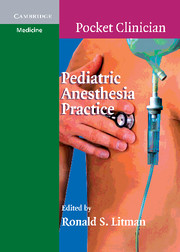Patent Ductus Arteriosus to von Willebrand Disease
from PART ONE - COEXISTING DISEASES
Published online by Cambridge University Press: 10 November 2010
Summary
BACKGROUND
▪ Incidence 1:2,500–5,000 births
▪ More common in prematures
▪ Usually closes spontaneously within days to wks after birth
▪ Persistent L to R shunting may lead to CHF & pulm hypertension if untreated.
▪ Surgical correction by transcatheter closure (coil or device) or surgery (thoracotomy for ligation)
PREOPERATIVE ASSESSMENT
▪ Hx: R/O previous recurrent laryngeal nerve injury
▪ BP: compare extremities
▪ CBC: if chronic cyanosis R/O polycythemia
▪ Echo: assess residual PDA, severity of shunt, direction of flow, RV size & hypertrophy, and estimate RV pressure. R/O other CHD. Evidence of pulm htn: R to L or bidirectional shunting, RV dilation or hypertrophy, cyanosis, or RV dysfunction.
▪ ECG: RVH or LVH
▪ If PDA not corrected, look for pulm htn: cardio consult.
INTRAOPERATIVE MANAGEMENT
▪ SBE prophylaxis indicated if PDA closed within 6 mos
▪ SBE prophylaxis if residual flow or closure device implanted
▪ If PDA uncorrected, be aware of PVR/SVR ratio and direction of shunting.
POSTOPERATIVE CONSIDERATIONS
▪ Std analgesic regimens
POST-OPERATIVE NAUSEA AND VOMITING (PONV)
BACKGROUND
▪ Prevalence higher than adults; schoolchildren up to 50%; infants 5%; preschool children 20%
▪ Intractable vomiting 1–3%
▪ Higher incidence in post-pubertal females
▪ Increased incidence in T&A, strabismus repair, orchiopexy, herniotomy, middle ear surgery & laparotomy
▪ Associated with prolonged surgical/anesthetic time & hx of motion sickness or PONV
[…]
- Type
- Chapter
- Information
- Pediatric Anesthesia Practice , pp. 28 - 48Publisher: Cambridge University PressPrint publication year: 2007



